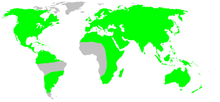| Sac spiders Temporal range:
| |
|---|---|

| |
| Clubiona trivialis | |
| Scientific classification | |
| Domain: | Eukaryota |
| Kingdom: | Animalia |
| Phylum: | Arthropoda |
| Subphylum: | Chelicerata |
| Class: | Arachnida |
| Order: | Araneae |
| Infraorder: | Araneomorphae |
| Family: | Clubionidae Simon, 1878 |
| Diversity | |
| 18 genera, 659 species | |

| |
The sac spiders of the family Clubionidae[1] have a very confusing taxonomic history. Once, this family was a large catch-all taxon for a disparate collection of spiders, similar only in that they had eight eyes arranged in two rows[2] and conical anterior spinnerets that touched, and were wandering predators that built silken retreats, or sacs, usually on plant terminals, between leaves, under bark, or under rocks. These are now recognized to include several families, some of which are more closely related to the three-clawed spiders, like lynx and wolf spiders, than to Clubionidae and related families.[3]
YouTube Encyclopedic
-
1/3Views:11 679497651
-
Don't Fear The Yellow Sac Spider
-
Bashful Bullheaded Sac Spider
-
Handling and observing the sac spider [Clubiona sp]
Transcription
Genera
The remnant Clubionidae now consist of a few over 500 species in 18 genera worldwide. However, "sac spider" used on its own should imply a member of the family Clubionidae, but other common names may use the phrase "sac spider" including:
- Anyphaenidae (anyphaenid sac spider)
- Corinnidae (corinnid sac spider)
- Liocranidae (liocranid sac spider)
- Miturgidae (long-legged sac spider)
- Tengellidae (merged into Zoropsidae)
- Zorocratidae (merged into Zoropsidae)
As of January 2023[update], the World Spider Catalog accepts the following genera:[4]
- Arabellata Baert, Versteirt & Jocqué, 2010 — New Guinea
- Bucliona Benoit, 1977 — St. Helena, Kenya, Russian Far East, Korea, Japan, China, Taiwan
- Clubiona Latreille, 1804 — Africa, North America, Asia, Oceania, South America, Europe, Panama
- Clubionina Berland, 1947 — St. Paul Is.
- Elaver O. Pickard-Cambridge, 1898 — North America, Caribbean, Central America, South America, Philippines
- Femorbiona Yu & Li, 2021 — China, Vietnam
- Invexillata Versteirt, Baert & Jocqué, 2010 — New Guinea
- Malamatidia Deeleman-Reinhold, 2001 — Indonesia, Laos, Malaysia
- Matidia Thorell, 1878 — Asia, Papua New Guinea
- Nusatidia Deeleman-Reinhold, 2001 — Asia
- Porrhoclubiona Lohmander, 1944 — Asia, Africa, Europe
- Pristidia Deeleman-Reinhold, 2001 — Indonesia, Thailand, Malaysia
- Pteroneta Deeleman-Reinhold, 2001 — Asia, Australia
- Ramosatidia Yu & Li, 2021 — China
- Scopalio Deeleman-Reinhold, 2001 — Indonesia
- Simalio Simon, 1897 — Asia, Trinidad
- Sinostidia Yu & Li, 2021 — China
- Tixcocoba Gertsch, 1977 — Mexico
Additionally, the World Spider Catalog considers Carteroniella Strand, 1907 to be a nomen dubium.
In North America, the family as it is now recognised consists of only two genera, Clubiona and Elaver (formerly Clubionoides). Clubiona is nearly worldwide in distribution.
See also
References
- ^ "Sac Spiders, HYG-2060A-04". Archived from the original on 2009-03-05. Retrieved 2009-03-05.
- ^ "Clubionidae". www.bio.brandeis.edu. Retrieved 29 March 2018.
- ^ Tree of Life Web Project. 2006. Clubionidae. Version 25 March 2006 (temporary). http://tolweb.org/Clubionidae/2675/2006.03.25 in The Tree of Life Web Project, http://tolweb.org/
- ^ "Family: Clubionidae Wagner, 1887". World Spider Catalog. Natural History Museum Bern. Retrieved 18 January 2023.
External links
- Family Anyphaenidae Sac spiders, ghost spiders
- Australian sac spiders, family Clubionidae, Gnaphosidae, Miturgidae, Corinnidae
- [1]
- [2]
